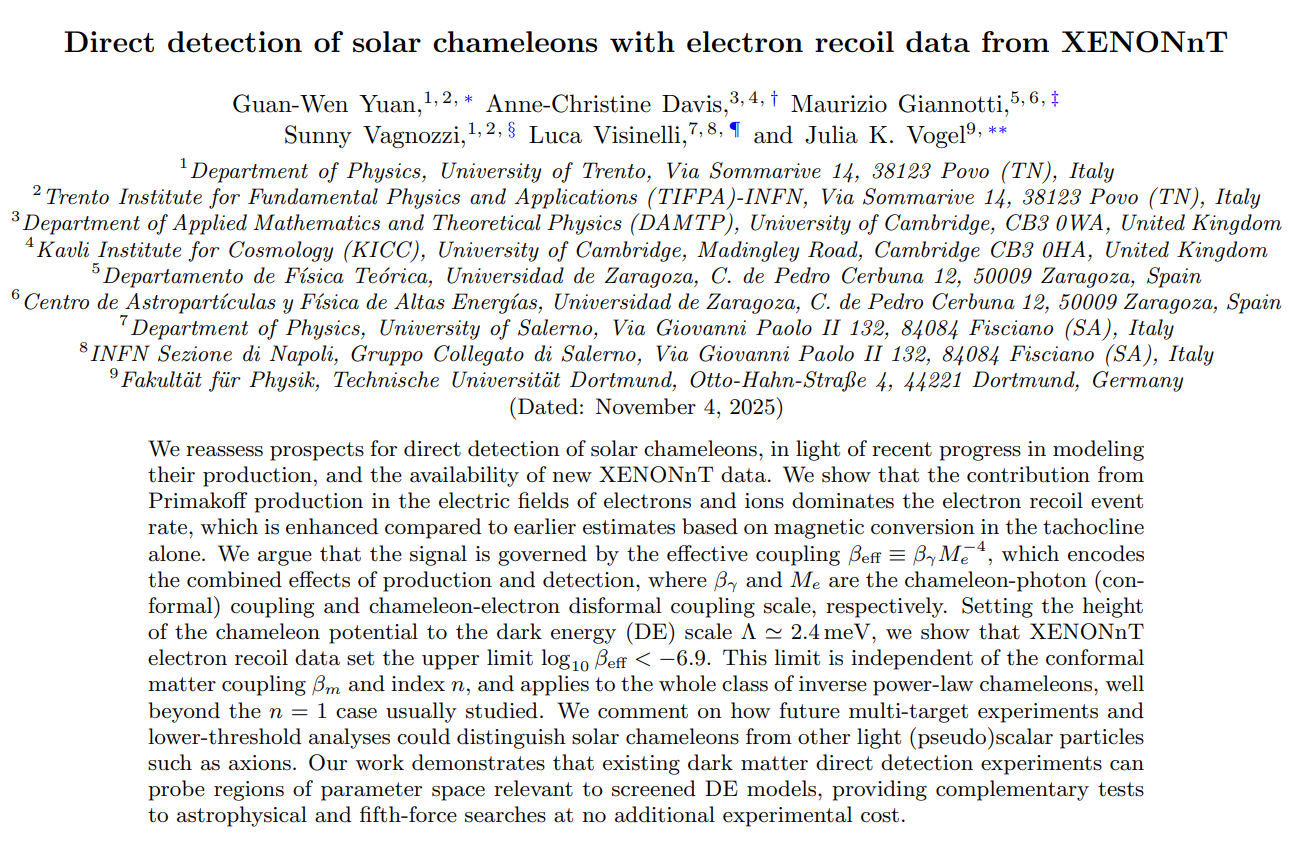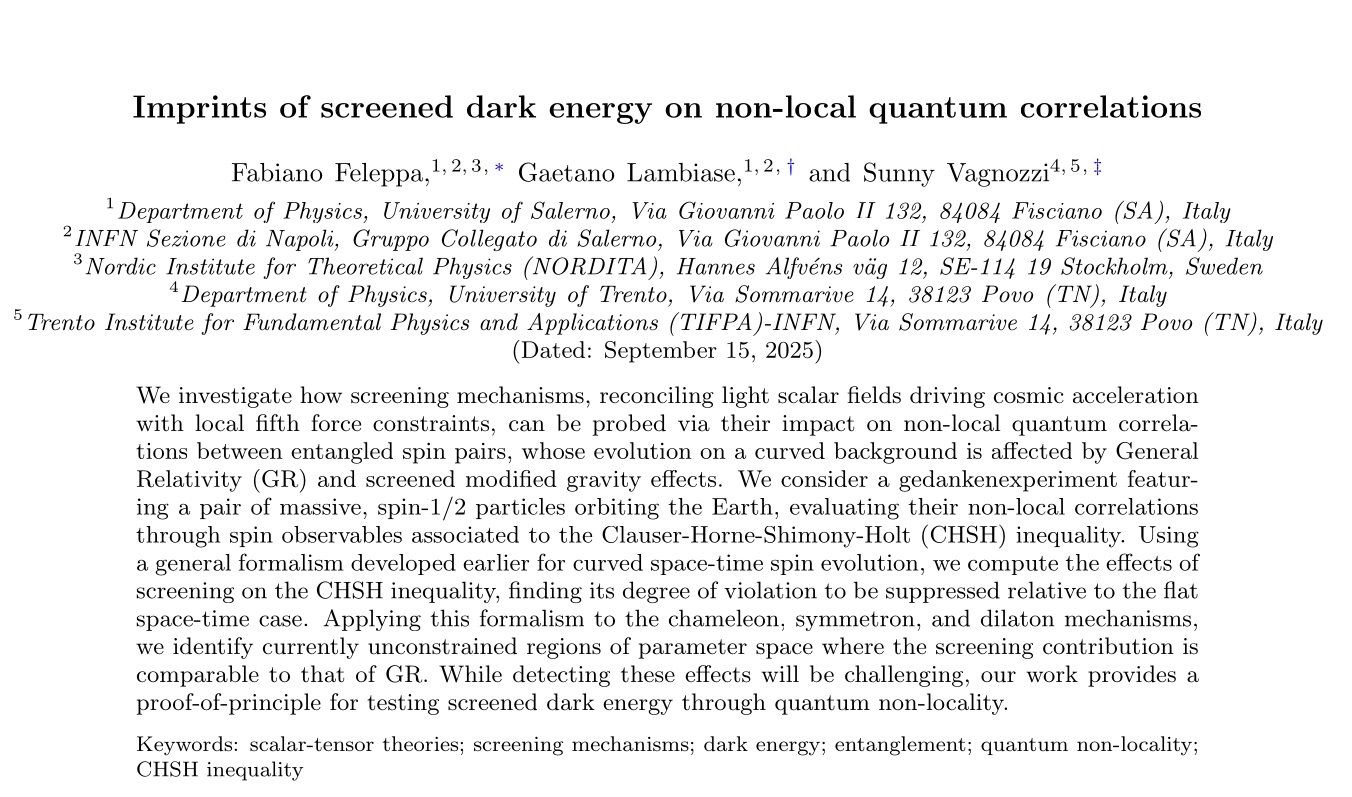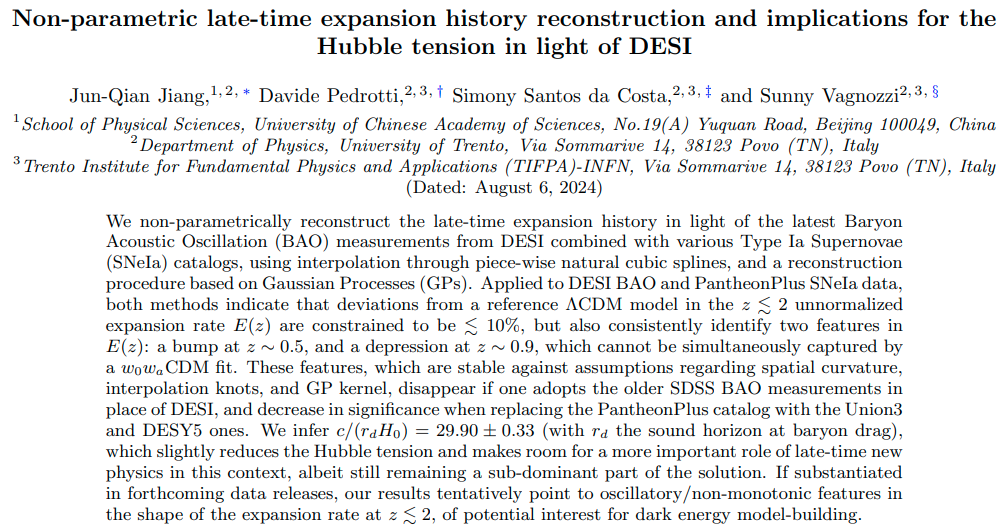Very happy to see my latest paper with Guan-Wen Yuan, Anne Davis, Maurizio Giannotti, Luca Visinelli, and Julia Vogel out on arXiv - kudos to Guan-Wen who did all the heavy lifting! This paper is essentially a merger of two previous papers of mine: in 2021 Luca, Anne, and I argued that dark matter direct detection experiment such as XENON1T could detect chameleons, light particles potentially related to dark energy, produced in the Sun (see paper in PRD), whereas later in 2024 some of us drastically improved the model for solar chameleon production, which was previously grossly incomplete to say the least (see paper in PRD and this earlier news item). What we did here was to combine the tools built in these two papers, applying the results to newer and much more sensitive data from XENONnT, and confirming the extremely important message that terrestrial dark matter experiments are well suited to probe screened dark energy at no extra experimental cost. We clarified various previously unclear points, and derived a new upper limit on a combination of chameleon couplings (specifically the conformal coupling to photons and the disformal coupling to electrons), valid for essentially all values of the chameleon power-law index n, making it one of the most widely applicable chameleon bounds to date. You can read the results in the preprint we just posted on arXiv: 2511.01655.
Screened dark energy and non-local quantum correlations paper published in PRD!
My paper with Fabiano Feleppa and Gaetano Lambiase, where we study non-local Bell-type quantum correlations between pairs of entangled particles within screened dark energy models (see this earlier news item), has now officially been published in PRD! The full bibliographic coordinates for the paper are Phys. Rev. D 112 (2025) 084011. Here is the link to the paper.
BAO and the Hubble tension no-go theorem
I’m extremely excited to finally see my latest paper with Davide Pedrotti, Luis Escamilla, Valerio Marra, and Leandros Perivolaropoulos, finally out on the arXiv - kudos to Davide who did all the heavy-lifting in what I do not hesitate to place among the three most important papers I ever wrote! This paper is about what we could call the “Hubble tension no-go theorem”, which forbids purely post-recombination solutions due to the constraints BAO impose on the product of the sound horizon and the Hubble constant. However, the pipeline from which BAO measurements are obtained requires assuming a fiducial cosmological model, with the choice falling on ΛCDM: many have therefore wondered whether we can trust these measurements when testing late-time modifications to ΛCDM, and this is the most frequently invoked loophole to the no-go theorem. In this work we have played devil’s advocate and showed that, even if BAO measurements were to be grossly (and unrealistically) biased by fiducial cosmology assumptions, this would still not be sufficient to rescue post-recombination solutions to the Hubble tension, primarily because of the extremely tight constraints on the (unnormalized) shape of the expansion history from unanchored SNeIa, whose role in the Hubble tension so far has been underappreciated. You can read our results in the preprint we just posted on arXiv: 2510.01974.
Giada Daldoss' BSc thesis defense
Congratulations to Giada Daldoss, who today successfully defended her BSc thesis (for the BSc degree in Mathematics), by the title of “Nozioni di base di Relatività Generale con applicazioni al problema dell’Energia Oscura”, which translates to “Basic notions of General Relativity with applications to the Dark Energy problem” (with the opponent being Prof. Valter Moretti)! In her thesis which I supervised, Giada introduced basic concepts of General Relativity, before discussing the most important observational indications of Dark Energy.
Screened dark energy and non-local quantum correlations paper accepted in PRD!
My paper with Fabiano Feleppa and Gaetano Lambiase, where we study non-local Bell-type quantum correlations between pairs of entangled particles within screened dark energy models (see this earlier news item), has been accepted for publication without changes in PRD! You can read the preprint version of our paper on arXiv: 2508.18448.
Screened dark energy and non-local quantum correlations
Very happy to see my latest preprint with Fabiano Feleppa and Gaetano Lambiase from the University of Salerno finally out on the arXiv - kudos to Fabiano who did all the heavy-lifting and an excellent job! We focused on so-called screened dark energy/modified gravity models, where the would-be fifth force associated to a new light scalar degree of freedom responsible for cosmic acceleration is dynamically suppressed through, you guessed it, screening mechanisms, such as the chameleon, symmetron, and dilaton ones. We showed that these mechanisms can leave their imprint in non-local Bell-type correlations between pairs of entangled particles, leading to potential new observational signatures in currently unconstrained regions of parameter space. These will not be easy to detect, but if anything that’s a challenge for future generations of experimentalists! You can read our results in the preprint we just posted on arXiv: 2508.18448.
Leonardo Comini’s MSc defense
Congratulations to Leonardo Comini, who today successfully defended his MSc thesis, by the title of “Testing cosmological models with JWST high-redshift galaxies” (with the opponent being Prof. Albino Perego), receiving the final grade of 110/110! In his thesis which I supervised, Leonardo studied the possibility of testing cosmological models (focusing on dark energy) in a statistically robust way using high-redshift galaxies from JWST, focusing both on photometric and spectroscopic samples, and finding that despite the relatively large error bars some of these samples can indeed give interesting cosmological information. We are planning to write up our results in a paper relatively soon, so stay tuned for more!
Visit by Anjan Sen and Antonio Junior Iovino
For the next few days we have the pleasure of hosting Anjan Sen (who already visited us two years ago) and Antonio Junior Iovino, visiting us from Jamia Millia Islamia and NYU Abu Dhabi respectively. They will be giving us two talks respectively on an innovative way of measuring the low-redshift expansion rate and constrain the physics of Dark Energy at characteristic redshifts, and on recent important developments in primordial black hole physics. Welcome Anjan and Antonio!
Mattia Scotto's MSc defense
Congratulations to Mattia Scotto, who today successfully defended his MSc thesis, by the title of “Dark Energy models featuring negative energy densities: growth of structure and novel perturbation-level signatures” (with the opponent being Prof. Albino Perego)! Mattia’s defense was outstanding, and he received top grades and honours, i.e. 110 e Lode (making me a very proud advisor, with this being the third 100 e Lode in a row for my amazing MSc students, after Davide Pedrotti and Giovanni Piccoli). In his thesis which I supervised, Mattia studied dark energy models featuring negative energy density components, including a negative cosmological constant with an evolving component with positive energy density on top, and a sign-switching cosmological constant. He studied in detail the growth of structure, late ISW effect, and signatures in the cross-correlation between CMB temperature anisotropies and galaxy clustering, finding however that current data has too low signal-to-noise for one to search for these signatures. During the same day, I also served as opponent for Arianna Balduzzi, an outstanding MSc student of Prof. Max Rinaldi who defended her thesis studying reheating and preheating in scale-invariant inflation.
Post-DESI neutrino cosmology paper published in JCAP!
My paper with Jun-Qian Jiang, William Giarè, Stefano Gariazzo, Maria Giovanna Dainotti, Eleonora Di Valentino, Olga Mena, Davide Pedrotti, and Simony Santos da Costa, where we investigate the status of (positive) neutrino mass cosmology after the latest DESI measurements (see this earlier news item), has now officially been published in JCAP! The full bibliographic coordinates for the paper are JCAP 2501 (2025) 153. Here is the link to the paper (which is published Open Access).
Post-DESI neutrino cosmology paper accepted in JCAP!
My paper with Jun-Qian Jiang, William Giarè, Stefano Gariazzo, Maria Giovanna Dainotti, Eleonora Di Valentino, Olga Mena, Davide Pedrotti, and Simony Santos da Costa, where we investigate the status of (positive) neutrino mass cosmology after the latest DESI measurements (see this earlier news item), has been accepted for publication in JCAP! The paper has undergone has a substantial revision, which resulted in the addition of several appendices clarifying various technical aspects of the analysis (e.g. cosmology-internal tension, impact of PR4 likelihoods, and H0 versus MB prior among others), as well as an additional useful plot, and useful discussions on the neutrino mass ordering: however, the main results are unaltered, and are now more robust. You can read the preprint version of the paper on arXiv: 2407.18047.
Non-parametric expansion history reconstruction paper published in PRD!
My paper with Jun-Qian Jiang, Davide Pedrotti, and Simony Santos da Costa, where we perform a non-parametric reconstruction of the late-time expansion history in light of DESI BAO data (see this earlier news item), has now officially been published in PRD! The full bibliographic coordinates for the paper are Phys. Rev. D 110 (2024) 123519. Here is the link to the paper.
Non-parametric expansion history reconstruction paper accepted in PRD!
My paper with Jun-Qian Jiang, Davide Pedrotti, and Simony Santos da Costa (first one entirely produced within my group), where we perform a non-parametric reconstruction of the late-time expansion history in light of DESI BAO data (see this earlier news item), has been accepted for publication in PRD! Compared to the earlier version, there have been minor changes to the plots and title, but our main results are unaltered. You can read the preprint version of the paper on arXiv: 2408.02365.
Solar chameleons paper published in PRD!
My paper with Tom O'Shea, Anne Davis, Maurizio Giannotti, Luca Visinelli, and Julia Vogel, where we revisited the issue of production of Solar chameleons (see this earlier news item), has now officially been published in PRD! The full bibliographic coordinates for the paper are Phys. Rev. D 110 (2024) 063027. Here is the link to the paper (which is published Open Access).
Stochastic gravitational wave background from cosmologically coupled black holes
Very happy to see my latest paper with Marco Calzà, Francesco Gianesello, and Max Rinaldi out! This is a 100% “made in Trentino” paper, and more precisely made within the Theoretical Gravitation and Cosmology Group led by myself and Max. At some point in 2023, the possibility that dark energy could be sourced by cosmologically coupled black holes (BHs), whose mass increases in time through purely cosmological growth even in the absence of accretion and merger events, received a lot of interest, especially given the possibility that signatures of such a coupling could have been observed in the growth of supermassive BHs in red-sequence elliptical galaxies. In today’s paper we show that mergers of such cosmologically coupled BHs would lead to a stochastic gravitational wave background whose strength is significantly larger (up to an order of magnitude stronger!) than the standard one from mergers of uncoupled BHs, with very interesting implications for the signal observed last year by pulsar timing arrays (among which NANOGrav, EPTA, PPTA, and CPTA), which is a bit too strong to be easily explainable by mergers of standard BHs. You can read our results in the preprint we just posted on arXiv: 2409.01801.
Solar chameleons paper accepted in PRD!
My paper with Tom O'Shea, Anne Davis, Maurizio Giannotti, Luca Visinelli, and Julia Vogel, where we revisited the issue of production of Solar chameleons (see this earlier news item), has been accepted for publication in PRD! Minor revisions compared to the previous version include a rough estimate of how much the CAST bound on the chameleon-photon coupling changes accounting for the production channels we studied. You can read the preprint version of the paper on arXiv: 2406.01691.
Non-parametric expansion history reconstruction and Hubble tension after DESI
I’m particularly excited and proud about today’s paper, which is the first one written entirely and exclusively with members of my group: visiting PhD student Jun-Qian Jiang (who did all the heavy lifting), PhD student Davide Pedrotti, and postdoc Simony Santos da Costa. What we did has been to perform a non-parametric reconstruction of the late-time expansion history in light of DESI BAO data, combined with various SNeIa datasets, using both interpolation and Gaussian Process reconstruction techniques, and studying implications for the Hubble tension. We find that the shape of the expansion history cannot deviate more than 10% from that of ΛCDM, but within that 10% we find interesting deviations which could hint to a non-monotonic/oscillatory behaviour of the expansion rate (and therefore of the dark energy component). I really believe that this can be a pretty important paper, as it represents a much needed revisitation in light of DESI of two seminal papers in the expansion history reconstrcution and Hubble tension literature: the famous “Trouble with H0” paper by Bernal, Verde, & Riess, and the equally famous “Sounds discordant” paper by Aylor and collaborators. You can read our results in the preprint we just posted on arXiv: 2408.02365.
Negative cosmological constant and JWST paper (part 2) published in JCAP!
My paper with Nicola Menci, Shahnawaz Adil, Upala Mukhopadhyay, and Anjan Sen, where we robustly compare a dark energy model featuring a negative cosmological constant against JWST data (see this earlier news item), has now officially been published in JCAP! The full bibliographic coordinates for the paper are JCAP 2407 (2024) 072. Here is the link to the paper (which is published Open Access).
Post-DESI neutrino cosmology
Another paper out today! Led by Jun-Qian Jiang and William Giarè (both of whom did a huge amount of work), and together with Stefano Gariazzo, Maria Giovanna Dainotti, Eleonora Di Valentino, Olga Mena, Davide Pedrotti, and Simony Santos da Costa, we investigate the status of (positive) neutrino mass cosmology after the latest DESI measurements. We find very tight upper limits on the sum of the neutrino masses, a strong preference for the normal ordering, and a significant tension with terrestrial observations, all of which we carefully quantify. We also studied the impact of allowing the dark energy component to be non-phantom, which makes all the previous conclusions somewhat stronger, and highlights an interesting synergy between laboratory experiments aimed at determining the neutrino mass ordering, and the nature of dark energy. You can read our results in the preprint we just posted on arXiv: 2407.18047.
Negative cosmological constant and JWST paper (part 2) accepted in JCAP!
My paper with with with Nicola Menci, Shahnawaz Adil, Upala Mukhopadhyay, and Anjan Sen, where we robustly compare a dark energy model featuring a negative cosmological constant against JWST data (see this earlier news item), has been accepted for publication in JCAP! The results are basically unchanged compared to our earlier version, with certain aspects of our analysis better clarified. You can read the preprint version of the paper on arXiv: 2401.12659.


















